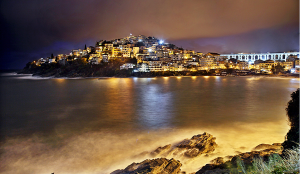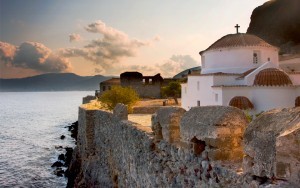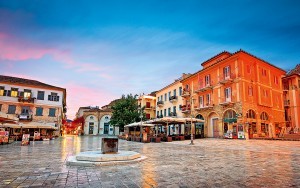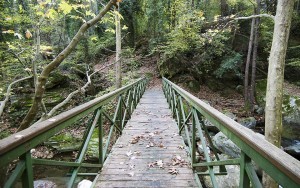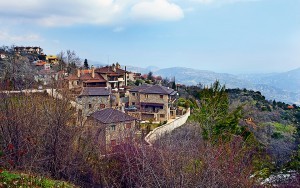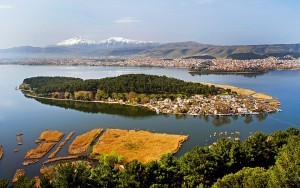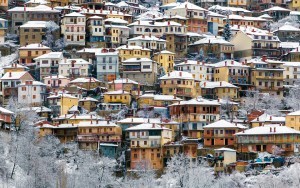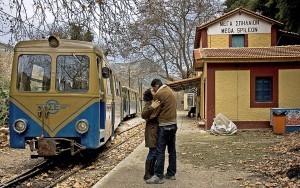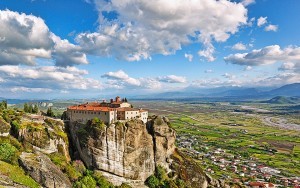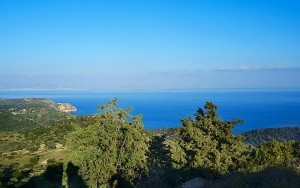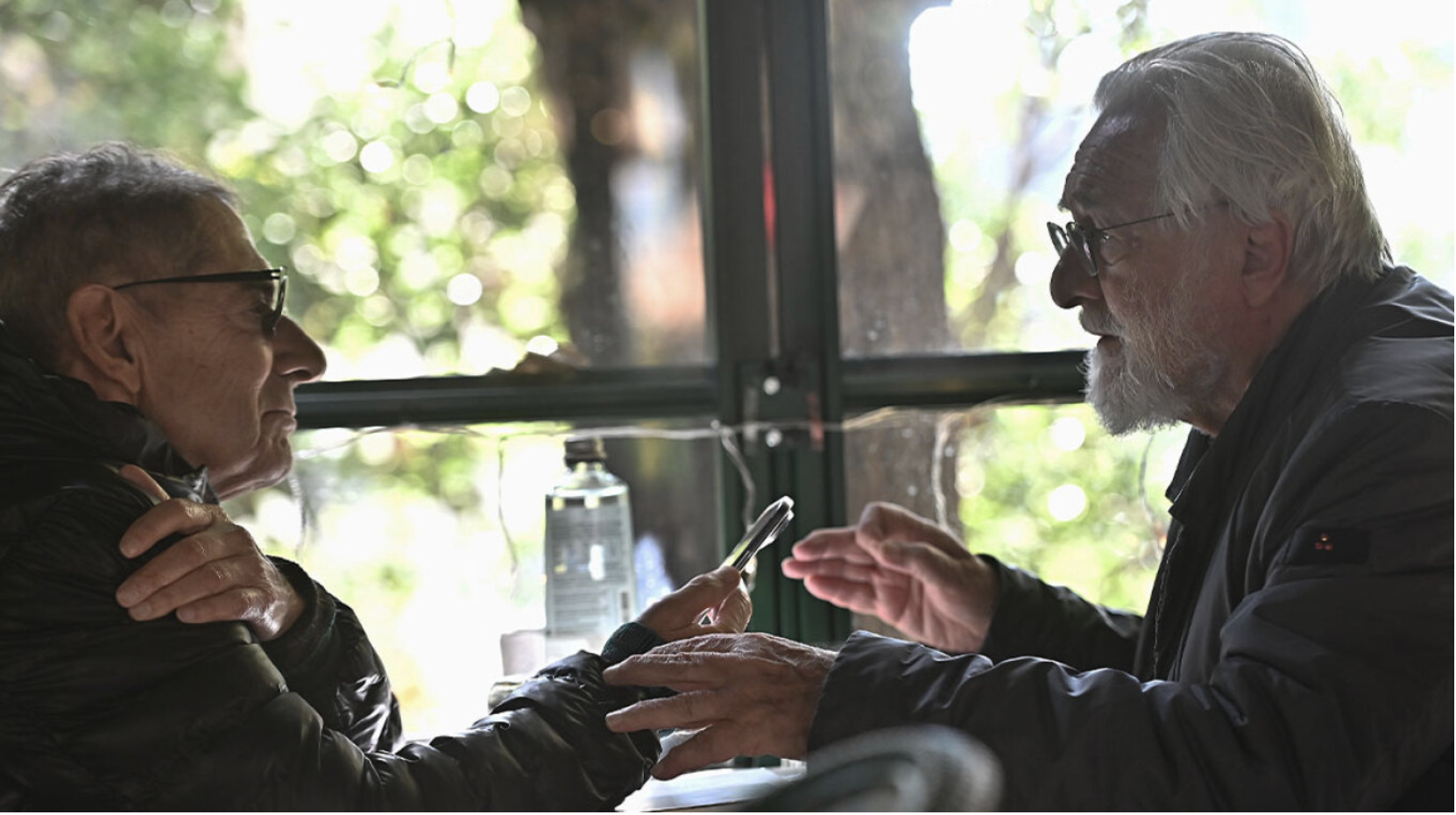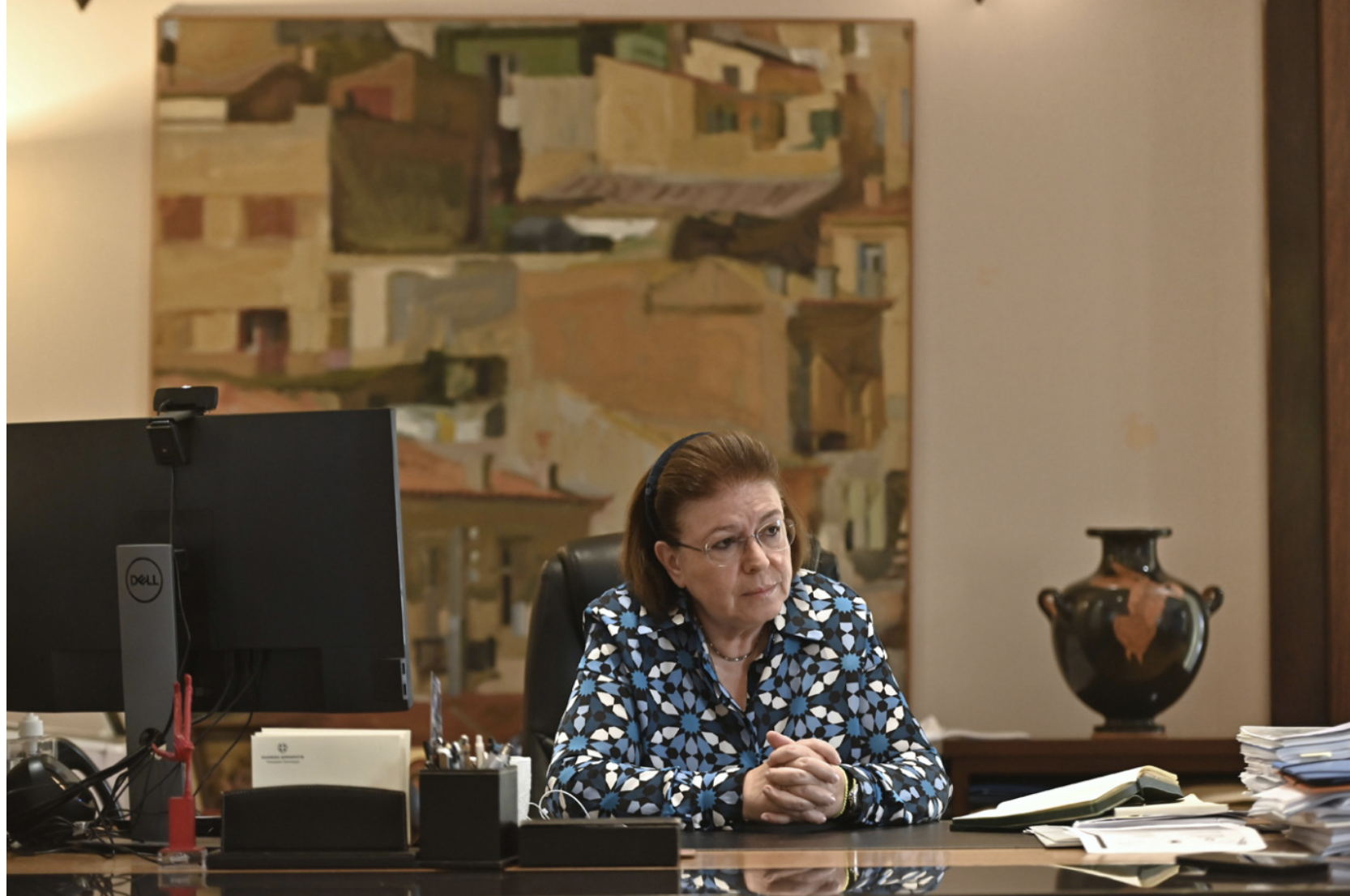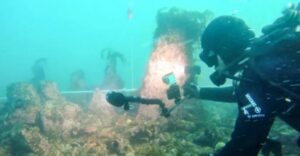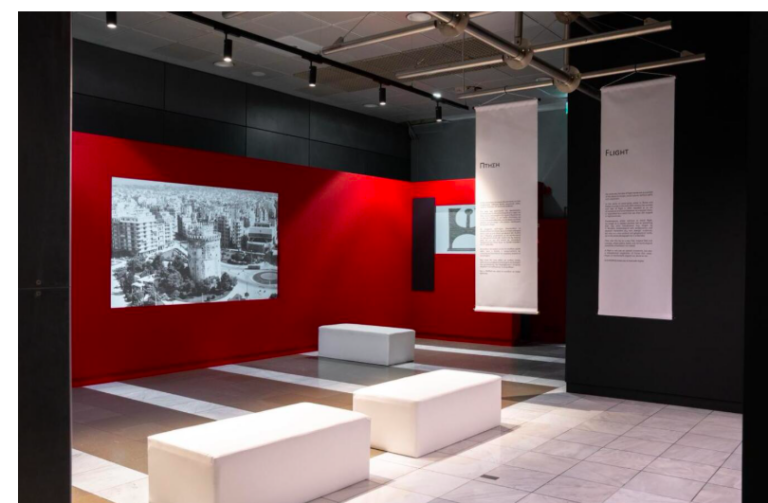MONEMVASIA: SUNSET AT THE CASTLE
Enter through the gateway of the fortified Byzantine city and enjoy a fabulous weekend within its walls. Take a walk along the main cobbled pathway passing between small souvenir shops, as well as cafes and tavernas. Have a hot beverage on one of the little rooftops and then lose yourself amid stone-paved streets and arches.
The castle area’s past stands before you – mansions, Venetian coats of arms, Byzantine churches, arcades, old walls, squares. A nighttime walk around the discreetly lit alleys is a magical experience. Walk up to the mosque, enjoy the view and take a snapshot by the renowned canon.
Gaze out towards the Myrtoan Sea from the sea wall. Feel the tranquility at Panagia Chrysafitissa church and find the passage heading to Portelo, the coastal gateway leading next to the sea.
Share the experience of Ano Poli (Upper Town) with your partner. When the sun begins to set, walk up the cobbled path leading to what remains of the town’s aristocratic district. Once at this elevated point, take in the grand sight offered from the castle and the impressive sunset view from next to Aghia Sofia church.
NAFPLIO: GREECE’S CAPITAL OF ROMANCE
Lose yourself along cobbled paths, admire neoclassical buildings, sit at Venetian-era squares and make your way up to Palamidi fortress.
Nafplio, the first capital of modern Greece during the early years of the revolution, features ancient walls, Venetian castles, mosques, marble lion sculptures (Venetian or Bavarian) and Ottoman fountains with Venetian elements.
Nafplio is pedestrianized but may also be enjoyed by bicycle, bicycle-taxis, even little train rides. It is worth visiting Syntagma Square and the first Greek Parliament building, locally known as the Vouleutiko, the old mosque, and the interesting archaeological museum.
Locate Aghios Spyridonas church, where Ioannis Kapodistrias, the first head of state of independent Greece, was assassinated on the church steps. Head up to Acronafplia and marvel at the city walls, the view, as well as the best sunset from the clock tower (Roloi). The Tour of Arvanitia, as the route below the wall by the sea is known, is a beautiful walk.
If you’re physically up to it, climb the 853 steps – not 999, as is frequently said – up to Palamidi. Otherwise, opt for a relaxing and pleasant boat ride to Bourtzi castle, out in the middle of the harbor.
TSAGARADA: WALKS IN NATURE
Pelion, a mountainous area by the mainland’s east coast in central Greece, is renowned for its traditional villages, hostels, taverns, and ski resort. The cobbled paths passing through the villages are an off- beat viewing sensation. Winter here is ideal for trekking, either along winding cobbled paths with a view of the nearby Sporades cluster of Greek islands, or along dirt tracks passing through densely vegetated gullies.
Definitely do put on your hiking boots for the wonderful one-and-a-half hour trek from Tsagarada to Damouchari. The more intrepid can head down a cobbled path for a view of the sea. This route reaches all the way down to the sea.
The marked path begins at Agia Paraskevi square (www.pelion-paths.gr). Alternatively, it is worth walking through the four Tsagarada districts – Agia Kyriaki, Agios Stefanos, Agia Paraskevi, and Taxiarhes – and reaching the area’s most elevated part for a magnificent view of the Aegean Sea. The houses lining this route are of exceptional architectural quality, while the running waters and dense vegetation are awe inspiring.
JOURNEY TO KAVALA
Take a walk to Panagia, the old district of the provincial city of Kavala in northern Greece, featuring traditional Macedonian, Ottoman, and neoclassical buildings. Visit the intriguing little house, once resided by Muhammad Ali Pasha, – the Ottoman Albanian commander born in Kavala – which has been transformed into a museum. Also inspect the Halil Bey complex, referred to as Palia Mousiki by locals. It’s comprised of a mosque, a madrasah, or Islamic school, and a glass floor with a view of the Byzantine church of Aghia Paraskevi below.
Venture up to the castle for great views in every direction.
Follow that up with an outing to the new part of town with its old tobacco warehouses and the Tobacco Museum. Discover the old market lined with small shops. Walk under impressive arches (Kamares) and enjoy a relaxing stroll by the sea.
TRIP TO TRIKALA (CORINTH)
The three Trikala (of Corinth) districts, Kato, Mesea, and Ano – meaning lower, mid, and upper, respectively – each have their own surprise in store.
At Kato Trikala, Agios Dimitrios church features an expressionist mural depicting Christ as a Man of Sorrows. At Mesea Trikala, seek out the icon of St John the Baptist, an exquisitely crafted piece of work by icon artist Petros Valvis in 1816, at the Metamorfosis Tou Sotiros church. At Ano Trikala, the oldest of the three districts and most established in the tourism industry, visitors can view the remains of mansions dating back to the Ottoman era.
Make sure to drive out to the Trikala ski resort or visit the horse riding club at Rethi. [www.orinesdrastiriotites.gr • Tel. (+30) 6936.889.973]
IOANNINA: MYSTICAL LAKE PAMVOTIDA
Experience the mist over Ioannina Lake, as Lake Pamvotida is commonly known, by taking the lakeside route, either on foot or by bicycle, stretching from Mavili square to the foot of the Kastritsa monastery. It covers a distance of 7- 8 kilometers.
Traces left by Christian, Jewish, and Muslim residents, who co-existed harmoniously in Ioannina for centuries, are visible at the city’s castle. Visit the Its Kale acropolis, the Fethiye mosque, the tomb of Ali Pasha – the regional Muslim Albanian ruler during the Ottoman era – the Byzantine museum, and sip your coffee at the old eateries (magiria). Stroll around the city’s pedestrianized historic center, with its numerous bars, meze (assorted dishes) shops, and cafes.
A visit to the inhabited islet within the lake is a must. It is reached by small boats that depart from the jetty (Molos). Once across, visitors can take walks through the village’s stone-paved paths or trek around the entire islet. A pit-stop at one of the islet’s renowned monasteries is worthwhile. There is museum focused on the life of Ali Pasha at the Agios Panteleimonas monastery, where he was slain.
METSOVO: WINE-TASTING, NATURE, TRADITION
Metsovo, located in Greece’s northwest, offers visitors a wide range of experiences. Go walking along the cobbled paths, a traditional feature in the wider Epirus region; visit the Folklore Museum; the Averoff Museum of Neohellenic Art; and stop over at the Tositsa-Averoff Foundation cheese factory.
It has produced renowned cheese products, spearheaded by the renowned local metsovone cheese, since the 50s. Don’t forget to make a reservation for a wine-tasting tour at the Katogi Averoff winery. Art and functionality as well as homeliness and luxury co-exist at this winery. Video projections explain the history of the winery, which also operates a wine bar and an exceptional bottle shop.
It is also worth getting acquainted with the lush slopes of Pindos – Greece’s most extensive mountain range –, venturing around the artificial lake of Aoos springs, or driving along the spectacular route to Vovousa.
KALAVRYTA: ALL ABOARD THE RACK RAILWAY
Board the gauge rack railway, locally known as the odontoto, at Diakofto station, 160 kilometers from Athens in the northern Peloponnese, and cross the renowned Vouraikos Gorge.
The line, just over 22 kilometers in length, passes through immensely beautiful wild nature, hand-carved tunnels, over steel bridges, as well as a narrow gorge attributed by Greek mythology to Hercules, who created the passage to reach his love, the sea-dwelling Voura.
Kato Zahlorou, literally engulfed by nature, is the ride’s first stop, ideal for a coffee break and a look around. Head up the hill to the Megalou Spileou (Big Cave) monastery, two kilometers away.
After an hour’s journey, the train arrives at Kalavryta, which houses a municipal Holocaust Museum.
Serving as a further reminder of the Nazi occupation, the hands of the cathedral clock tower on the main square have remained fixed at 2.30 pm since December 13, 1943, when occupying forces torched the provincial city and executed its entire male population.
Catch a taxi to see all the city’s tourist attractions, such as the Place of Sacrifice (Topos Thysias), or the hilltop location, 500 meters from the city center, where the men were executed, and the Aghia Lavra monastery, one of Greece’s oldest.
METEORA: HOT AIR BALLOON TOURS
Love can certainly be likened to the air balloon tours (www.meteoraflights.com) offered at Meteora. A flame ignites and, suddenly, you’re flying. An ascent into the sky of the Thessaly region affords splendid views of the Meteora rocks, roughly 300-meters high, from an altitude of 5,000 feet, or roughly 1,500 meters.
From high up in the sky, these gigantic sandstone boulders look like exhibits at an open-air museum. The monasteries hanging off the boulders make for a truly picturesque setting. The view from the air balloons stretches well beyond Meteora to include vistas of the Thessaly flatlands, Trikala, Karditsa, the Pindos mountain range peaks, even snow-covered Mount Olympus. All that is probably required is a warm jacket. [Prices start at € 180 per person • Tel. (+30) 2310.222.413 (09.00-17.00]
MOUNTAINOUS AEGINA: HOT SPECIALTIES
The foot of Mount Hellanion on the island of Aegina, close to Athens, is home to some 30 locals living in the village of Anitseo. Most are shepherds with donkeys for their rides. From this point, the Saronic Gulf spreads out before you.
Angie Zissimatou-Droulia, who has lived in the village for years, promises a small tour of the area for all the couples that choose to visit this coming Valentine’s weekend. Her tour includes visits to an old mill once used to grind wheat, the Ai-Giorgis stone-built chapel, and, naturally, her very own small, traditional taverna, one of two operating in the area. Named “To Steki Tou Kinigou” (Hunter’s Hangout), the taverna is set in a 200-year-old structure that once served as a school. It is equipped with seven tables, two fireplaces, and offers the most delicious locally produced T-bone steak you’re ever likely to have, sided by locally grown fried potato. The bread loaves here are baked in a wood-fired oven for two-and-a-half hours. Other specialties on the menu include rooster with thick spaghetti and boiled goat. Try the homemade gremezi cheese, and, for dessert, sample the milk pie and loukoumades (fried fluffy dough pieces covered with cinnamon and honey).
[From €15 per person • Tel. (+30) 6938.501.852]
Ask me anything
Explore related questions
